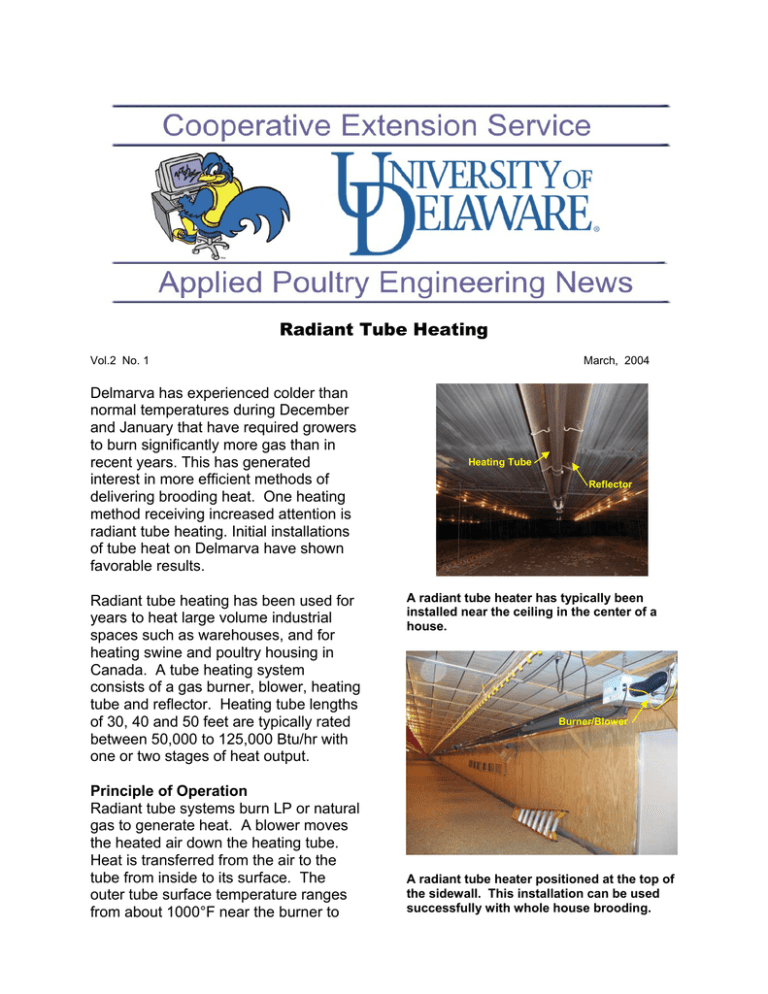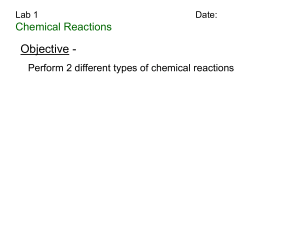Radiant Tube Heating
advertisement

Radiant Tube Heating Vol.2 No. 1 Delmarva has experienced colder than normal temperatures during December and January that have required growers to burn significantly more gas than in recent years. This has generated interest in more efficient methods of delivering brooding heat. One heating method receiving increased attention is radiant tube heating. Initial installations of tube heat on Delmarva have shown favorable results. Radiant tube heating has been used for years to heat large volume industrial spaces such as warehouses, and for heating swine and poultry housing in Canada. A tube heating system consists of a gas burner, blower, heating tube and reflector. Heating tube lengths of 30, 40 and 50 feet are typically rated between 50,000 to 125,000 Btu/hr with one or two stages of heat output. Principle of Operation Radiant tube systems burn LP or natural gas to generate heat. A blower moves the heated air down the heating tube. Heat is transferred from the air to the tube from inside to its surface. The outer tube surface temperature ranges from about 1000°F near the burner to March, 2004 Heating Tube Reflector A radiant tube heater has typically been installed near the ceiling in the center of a house. Burner/Blower A radiant tube heater positioned at the top of the sidewall. This installation can be used successfully with whole house brooding. 350°F near the far end of the tube. Heat from the bottom side of the tube is sent directly to the floor. Heat from the top of the tube hits the reflector surface and is redirected down to the floor. A tube system sends heat by radiant waves directly to the floor without having to heat the air in a house. This is the same method by which radiant heat travels 93 million miles from the Sun (10,000°F surface temperature) to warm Earth! Radiant heat transfers to heat surfaces (floors, walls, birds etc.) so that cooler air moving against these warm surfaces will pick up heat and warm the air to an adequate temperature. In general, all surfaces produce and send out radiant heat waves; the warmer a surface, the more heat waves a surface sends out per square foot surface area. A tube heater with its warm surface temperatures sends out more heat to chickens (temperature less than 90°F) than they send back . A radiant tube heater is different from a furnace or pancake brooder because of how heat is transferred to the birds. Furnaces and pancake brooders heat the air and depend on moving it past the birds. Heat is transferred by convection. The problem with this method is that heated air naturally rises as it becomes warmer and less dense. While the warmest air rises to the ceiling, chickens need heat on the floor! In order to heat air around chicks to over 90°F the entire volume of air in a house must be heated to an even higher temperature. This isn’t an efficient use of expensive fuel. Advantages of Radiant Heaters Radiant tube heating systems have several advantages in poultry houses compared with conventional heaters. Furnaces take approximately 36 hours to preheat a poultry house prior to chick placement. A radiant tube heater can raise floor temperatures within a 3-hour time period. Heat is sent directly from the heating tube surface to the floor and birds. The litter will absorb the radiated heat, evaporate moisture and be drier than with conventional heaters. A warm dry floor will reduce ammonia generation. Less ammonia and a warm comfortable growth environment should result in improved bird production. Radiant tube heaters are mounted near the ceiling and have a small profile that doesn’t restrict ventilation air flow as furnaces do. These heaters also are out of the way of catch crews and during house clean outs. Heater Mounting Configurations Center Ceiling Radiant heating tubes are commonly mounted as a single row of tubes in the center ceiling or multiple rows centered with respect to the house width. This seems logical in order to radiate heat to the floor in a symmetrical manner to heat birds evenly. As house width is extended to 60 feet and beyond, two rows of tubes have become common. A radiant heating tube mounted in the center of a 60-foot wide house with a sample temperature distribution. Ceiling at Sidewall An interesting configuration of radiant tube heaters has recently migrated from Canada to the Eastern Shore. The heat tube is mounted at the ceiling, but within 8 feet of a sidewall. The unit is turned to a 45° angle. If the reflector behind the tube is properly turned, the radiant heat waves transfer quite nicely across the house and warm the floor as shown below. Comments from observers in the field report less than a 3°F temperature variation across the house width! A key advantage of this layout is that it works best with whole house brooding. Chicks have plenty of room to seek a comfort heater tube is center mounted, the sensor should be initially placed between the outer water line and feed line. Each tube unit should have its own sensor to create heat zones similar to heat zones using furnaces. Reports from manufacturers and equipment vendors indicate that a tube heater control temperature should be set 3 to 5°F lower than a furnace temperature setting under similar conditions. Maintenance and Safety It is important that a tube heater be cleaned between flocks, especially the reflector and tube surfaces. Dust covered surfaces won’t efficiently send heat waves to the floor. Overall, tube heaters require much less maintenance than furnaces and brooders. Observe manufacturer guidelines for clearance between the heater and adjacent surfaces. Make sure that ceilings will not drop insulation on heater surfaces. A radiant tube heating system mounted at the top a sidewall of a 60-foot wide house with a sample temperature distribution. zone. Growers won’t have to push birds down the house into new (cold) areas. Design Considerations Heating tube lengths of 40 or 50 feet seem to be most practical. A longer tube is not necessarily better. Tube temperature drops with tube length as heat is transferred to the floor. Longer tubes can result in heat variation on the floor. Allowable spacing between tube ends is 10 to 20 feet. Temperature sensors should be placed as close to the floor as practical. If the Drawbacks of Radiant Tube Systems Radiant tube heating systems have a significantly higher initial cost than the furnaces and brooders typically used by the poultry industry. Although heating poultry housing in the U.S. with radiant heat is rather new, it has been used to heat swine nurseries in the U.S. and Canada for years. The fact that radiant heat does not heat the air it passes through is a difficult idea for nearly everyone to understand. Since it is a different method of heat transfer, important questions arise. Knowledge of how warm to maintain air surrounding birds and the type and location of temperature sensor required to quantify radiant heat is needed. Some poultry companies have not encouraged using of radiant tube heaters because of their initial cost and questions concerning their management and operation. Specifying higher cost heaters raises the total equipment cost per house from $5000 to $10,000 per house depending on house size and heater cost. The Bottom Line More information is needed to fully verify the benefit of radiant tube heaters. It appears from early reports on Delmarva that the higher initial cost can be offset by improved production. Some reports have seen fuel savings as high as 30%, while others have not seen savings. As with all new equipment, energy savings and other benefits depend on proper use and management. New Sidewall Material Available Wall and ceiling surface materials inside poultry housing are subject to harsh conditions. Moisture, corrosive gases and physical damage from service equipment can destroy materials such as plywood and corrugated metal. Ceiling and sidewall materials are also subjected to abuse during cleaning and disinfection procedures between flocks. Sharply rising costs of steel and lumber have made a corrugated plastic sheet product a very attractive alternative for use on interior sidewalls and perhaps even the ceiling of poultry houses. One such product is a high-density polyethylene panel known as Plasti-Cor. These panels are manufactured by Paragon Plastic Sheet, Inc.* and are currently available through local poultry housing contractors. Durability is a key attribute of this product. It resists degradation by moisture, corrosion, UV radiation and chemicals. It is strong and difficult to penetrate. These panels can be pressure washed. This product isn’t perfect (yet). It is available in black and cream color; however, it has a glossy surface. For light control in poultry housing, a dull surface finish is desirable. The panels currently are available in 4 x 10 foot sheets. These are not convenient dimensions for covering a sidewall without either cutting or using extensive overlap of panels. Perhaps the most important information is cost. As of early February 2004, this product cost between $0.27 and $0.32 per square foot, depending on quantity shipped. For further information regarding this product, please contact the local sales representative, Frosty McDaniel of Lewes, DE at (302) 644-9776 or a local building contractor. * Mention of a trade or brand names are used only for information. The University of Delaware does not guarantee or warrant the standard of any product mentioned, nor does it imply approval of any product to the exclusion of others that may also be suitable. Garrett L. Van Wicklen Extension Poultry Engineer University of Delaware gvw@udel.edu (302) 856-2585 x397 Issued in furtherance of Cooperative Extension work, Acts of May 8 and June 14, 1914, in cooperation with the U.S. Department of Agriculture. The Delaware Cooperative Extension System (University of Delaware and Delaware State University) offers educational programs, materials, and equal opportunity employment to all people without regard to race, color, national origin, religion, sex, age, veteran status, or disability. Thanks to Mr. Bob Daniel, Thevco Electronics, for tube mounting diagrams and temperature distributions.




